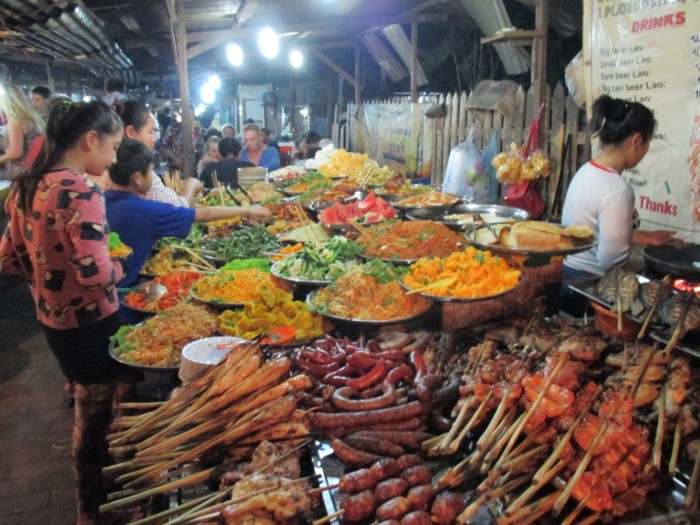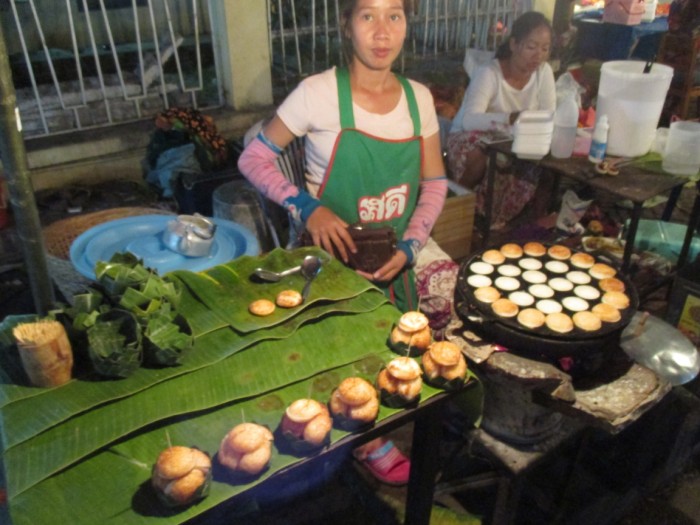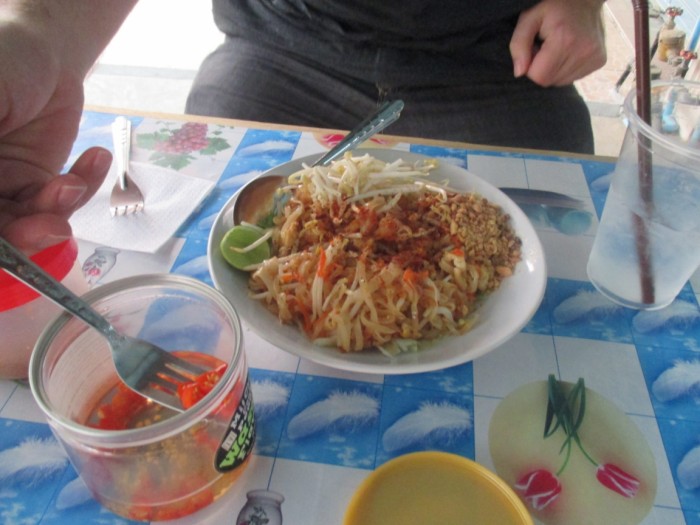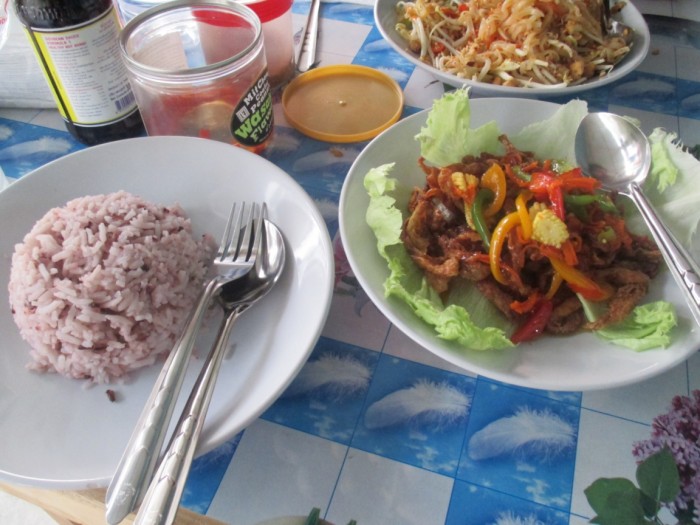I think it’s safe to say that wedding receptions are the most difficult and disappointing places to eat as a vegan. It’s so sad that there are even blogs devoted to the teeny plates of cantaloupe, grapes and lettuce that people are reduced to eating.
I used to laugh at those sad little salads, but now… now that I’ve experienced a Cambodian wedding dinner, I will always take whatever I can get, and be grateful at that.
While exploring Angkor Wat, we were invited by our tuk-tuk driver to attend his nephew’s wedding reception. Overjoyed at the chance, I put on my best, albeit dingy and travel dusted dress on, and headed out to large, open tent in the middle of a sweltering field. Trucks drove slowly past us with large blocks of ice in the back, ready to be shaved into people’s beer. (Yes, you definitely need to drink beer with ice there.) Little did I know, there would be seven, (SEVEN!) lovingly prepared courses set out for everyone to enjoy, and I would have to refuse them all (except for the salted peanuts, of course).
And as the whole, roasted animals were paraded in front of me, course by course, all of my new friends looked more and more puzzled at the way I didn’t eat. Finally, a small bowl, reserved I think for special guests, was passed to the table I was at. It was full of chicken heads and feet. These nice people kept trying to offer and re-offer it; and it was a struggle to politely smile and say no, while desperately averting my eyes, trying not to look outright disgusted. This was probably the most difficult and embarrassing episode I experienced in my travels.
I think it’s normal to feel nervous about traveling outside of your country. No matter how much you read, no matter how much you prepare, it’s difficult to feel confident. What if you get lost? What if you get ripped off? What if you miss your flight altogether? These are normal questions.
But, what if you can’t find anything to eat? As a committed vegan, I knew that this would probably be the biggest challenge during my four month journey. But I wanted to prove that you can still travel the world, experience different cultures and cuisines, while being vegan.
Southeast Asia has a vibrant blended religious history of Buddhism and Hinduism, so I began my journey with high hopes. There were all sorts of reactions to my diet, varying by country. Some people knew exactly what I was talking about, and had dishes made especially for me; some were vegan already, following a spiritual leader’s advice; some people obviously thought I was crazy, but tried to help me anyway; and very, very few, just didn’t care at all.
Here are some general tips I learned:
Smile. Just smile. It is so important to “save face” in these cultures, and being upset or angry will not help you, or help anyone understand you. It also just feels nice to smile. You’ll relax, and maybe think of a new way to approach the communication barrier. Which brings me to my next bit of advice.
Learn how to say “vegetables,” or “vegetarian” – most traditional dishes in Southeast Asia are made with coconut milk, not dairy. Some countries, like Vietnam, interpretations of “vegetarian” are basically in line with the Jain diet. (Jainism, for those who might not know, is an ancient religion whose believers follow a vegan diet, and also restrict the consumption of root vegetables, like onions and garlic.) And there are other places, especially very small towns, where no one will have any idea what a vegetarian is, even if you’re using the right word. Either you’ll easily see which dishes are veg, or you’ll get to practice your chicken imitations. (Yes, that happened.)
Try not to worry, because there are plenty of foods you can eat! – There were a surprising number of new dishes to enjoy – exotic fruits with questionable looking spiky skins, new vegetables stir fried with handfuls of colorful spices and garlic, fermented, cheese-like tofu, and tons and tons of mock meats, including many types of seitan and TVP. Mock meat heaven is in Southeast Asia.
There are outdoor markets, which are beautiful and lively, with low hanging tarps protecting the tables holding layers and layers of new fruits and vegetables, as well as some old familiar favorites. There are also small vendors in these markets; these are especially fun since you can eat food prepared there, in front of you, at a table with old, toothless, laughing women, and watch everyone shuffle through the narrow, winding paths of food carts. You can try to purchase some items to make at your hostel, but it’s usually just as cheap, if not cheaper, to buy from a vendor or a restaurant. So treat yo’self!
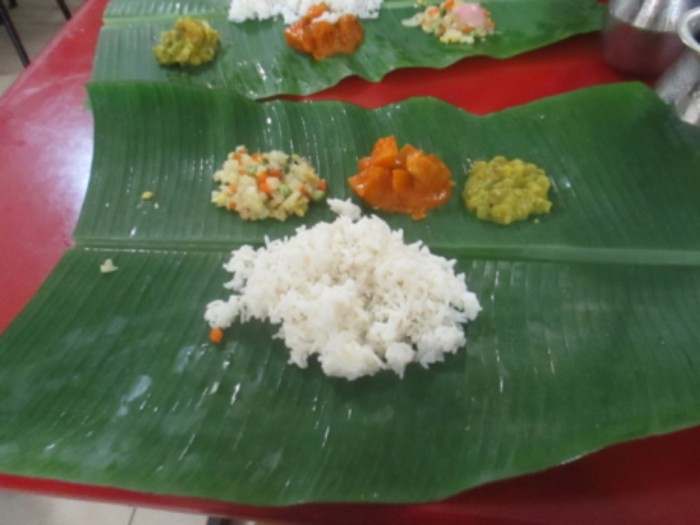
Little India’s banana leaf style lunch for only a dollar! You receive curry refills until you turn over your leaf!
Restaurants themselves are commonly set up in a buffet style. These are the best! You can simply point and smile at the things you want, and shake your head at the things you don’t need. There are also websites you can look at before you go out, like Happy Cow, which can tell you before you leave your hostel which restaurants will be friendly towards your diet.
Finally, know that there are some things that you will just never have control over; and that’s alright. I never found out if the beer that this local Vietnamese man had brewed and served to me was vegan, because there was no way I could have known. Or I would eat at a restaurant, ensure with the English speaking server that there was no butter in my dish, and then after I ate it, there would be a small pool of butter floating at the bottom of my bowl. Miscommunication will happen, no matter how good your chicken impersonation is, no matter how much you practiced drawing a cow on napkins, it will happen. You cannot control it.
Traveling helped me remember why I chose to change my diet – to reflect the compassion I feel for the animals we share this planet with. It was definitely not a decision to remain as “pure” as possible, but to refrain from causing harm as much as I can. I was not discouraged if a miscommunication or accident happened, because I knew that I tried my best.
So yeah, it was sometimes challenging to find food, but I never went hungry. I made a surprising number of friends, simply for seeking out the local vegan restaurant or vendor. I still got to experiment with different foods, and found new favorites to try to recreate at home. I still got to explore corners of the world that I’d never dreamed I’d be able to see. I don’t feel like being a vegan deprived my experience, in fact, I felt enriched and excited to discover another series of countries, and meet other people who cared about animals.
And the Cambodian wedding? Well, needless to say, it’s pretty rude to show up to someone’s wedding, and not eat a thing. Luckily, there was cold beer, and lots of dancing. So I tried to make up for my rudeness by taking anyone’s picture who asked, and drinking with anyone who reached their glass out to mine for a “cheers”. (That’s how Cambodians drink – you have to cheers with a friend, you can’t just sip your drink quietly.) I learned the traditional way to dance, and would dance to all of their songs. And you know what? It was still fun; no one was outrageously offended, people laughed and danced with me, tried to practice their English on me, and teach me some Khmer.
Don’t be afraid to travel; prepare yourself and research whether you will be able to eat out there, or if you’ll have to cook a lot of food yourself. If you feel inspired to learn more about the world, if you genuinely want a new perspective, I highly recommend abandoning the familiar for the exotic and mysterious.
More vegan travel tips: How to Eat Well Wherever You Travel
5 Budget Travel Tips to Take You Anywhere
Why You Should Travel Alone as a Woman
Get more like this–Subscribe to our daily inspirational newsletter for exclusive content!
__
Photo: Morgan Rogers

